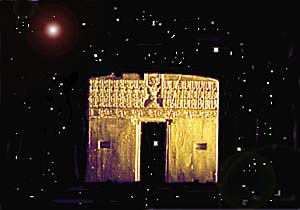

In tutte le culture originarie - e specificamente nel mondo andino - si mantiene solida nel cammino dei secoli la COSMOVISIONE. La Cosmovisione si basa sulla Cosmogonia, che è la fase mitologica della spiegazione del mondo. E’ quella visione globale della realtà in tutte le sue sfaccettature e manifestazioni, il cui obiettivo finale è l’armonizzazione di ogni elemento, materiale o spirituale, individuale o collettivo, che riconosce le diversità e le pluralità come ricchezze nell’unità.
Nel mondo andino il HANANPACHA, o mondo dei cieli, ospita gli esseri celestiali, le divinità,le costellazioni, gli astri, l’arcobaleno, i fulmini, le nubi; il KAYPACHA, o mondo terreno, mondo di qui, raduna gli esseri della terra, le montagne, i fiumi, i laghi, gli animali, le piante, gli esseri viventi; l’UCKUPACHA, o mondo interiore, mondo del mistero, è popolato dai MALLQUIS, che sono i semi ed anche gli antenati, che sono sepolti nella profondità della terra, affinché da essa nascano nuove vite.
Tra il mondo interiore, del mistero e il mondo terreno esiste una comunicazione fisica, attraverso le aperture della terra, grotte, crateri, lagune, chiamati PAQARINAS, legate all’origine degli esseri viventi
Tra il mondo terreno, il mondo di qui, e il mondo dei cieli la comunicazione è ideale, spirituale; l’uomo si converte nel mediatore ed interprete dei messaggi del mondo dei cieli.
Il mondo andino, nella sua ubicazione geografica nell’emisfero australe, riconosce come simbolo la costellazione della CROCE del SUD, chiamata fin dall’antichità, in quechua, CHAKANA, termine nato dall’unione delle parole CHAKA (ponte, unione) e HANAN (i cieli), o dalla stessa parola CHAKANA (scala), significando l’unione con il HANANPACHA, il mondo celestiale. Il disegno riconosciuto come CHAKANA è un’efficace e complessa rappresentazione grafica del concetto della COSMOVISIONE e dei livelli e collegamenti dei tre mondi simultanei, paralleli e comunicanti.
Todas las culturas originarias – y específicamente en el mundo andino – se fundamentan a lo largo de los siglos sobre la COSMOVISIÓN. La Cosmovisión se arraiga en la Cosmogonìa, que es la etapa mitológica de la explicación del mundo. Es aquella visión global de la realidad en todas sus facetas y manifestaciones, cuyo objetivo final es la armonización de cada elemento, material o espiritual, individual o colectivo, que reconoce las diversidades y las pluralidades como riquezas en la unidad.
En el mundo andino el HANANPACHA, o mundo de los cielos, hospeda a los seres celestiales, las deidades, las costellaciones, los astros, el arcoiris, los relámpagos, las nubes; el KAYPACHA, o mundo earthly, mundo de aquí, reune a los seres de la tierra, las montañas, los ríos, las lagunas, los animales, las plantas, los seres vivientes; el UCKUPACHA, o mundo interior, mundo del misterio, está poblado por los MALLQUIS, que son las semillas y también los ancestros, que están enterados en la profundidad de la tierra, para que nazcan de ellos unas nuevas vidas.
Entre el mundo interior, del misterio y el mundo earthly existe una comunicación física, por las aberturas de la tierra, cuevas, crateres, lagunas, llamadas PAQARINAS, relacionadas con el orígen de los seres vivientes.
Entre el mundo earthly, el mundo de aquí, y el mundo de los cielos la comunicación es ideal, espiritual; el hombre se convierte en el mediador e intérprete de los mensajes del mundo de los cielos.
El mundo andino, en su ubicación geográfica en el hemisferio austral, reconoce como símbolo la constelación de la CRUZ del SUR, llamada desde los tiempos antiguos, en quechua, CHAKANA, término originado de la unión de las palabras CHAKA (puente, unión) y HANAN (los cielos), o de la misma palabra CHAKANA (escalera), significando la unión con el HANANPACHA, el mundo celestial. La imágen conocida como CHAKANA es una eficaz y compleja representación gráfica del concepto de la COSMOVISIÓN y de los niveles y conexiones de los tres mundos simultáneos, paralelos e intercomunicantes.
All the native cultures - and specifically in the andean world – are based, all the centuries along, upon the COSMOVISIONE. The Cosmovision is based upon the Cosmogony, which is the mithological phase of the world explication. It is that global vision of reality in all its multiple aspects, whose final objective is to harmonize all the elements, material or spiritual, individual or social ones, recognizing the diversities and the pluralities as richnesses in the unity.
In the Andean world, the HANANPACHA, or the heavenly world, hosts the spiritual entities, the divinities, the costellations, the asters, the rainbow, the lightenings, the clouds; the KAYPACHA, or earthly world, the world of “here”, gets together all the inhabitants of the earth, the mountains, the rivers, the lakes, the animals, the plants, the living beings; the UCKUPACHA, or the internal world, the world of the mistery, is populated by the MALLQUIS, who represent the seeds and also the ancestors, buried in the deepen of the earth, so that from there new lives will be born.
Between the internal world, of the mistery, and the earthly one, there is a physical communication, through the earth’s openings, caves, craters, lagoons, called PAQARINAS, related to the origin of the living beings.
Between the earthly world, the world of “here” and the heavenly world, the communication is ideal, spiritual; the man becomes the mediator and the interpreter of the messages of the heaven world.
The andean world, in its geographical location in the southern hemisphere, recognizes as a symbol the constellation of the SOUTHERN CROSS, called since the ancient ages, in quechua, CHAKANA, a world born from the union of CHAKA (bridge, union) and HANAN (heaven), or from the same word CHAKANA (stair), meaning the union with HANAHPACHA, the heavenly world. The image known as CHAKANA is an effective and complete graphic representation of the concept of COSMOVISION and the levels and connecyion of the three worlds, simultaneous and intercommunicating.


1 commento:
I Mondi SIMULTANEI sono interpretati da la Teoria dell' Entanglement vedi in La Scienza della Qualita' in edscuola.it/LRE.html
paolo manzelli 24 NOV 2007
Posta un commento